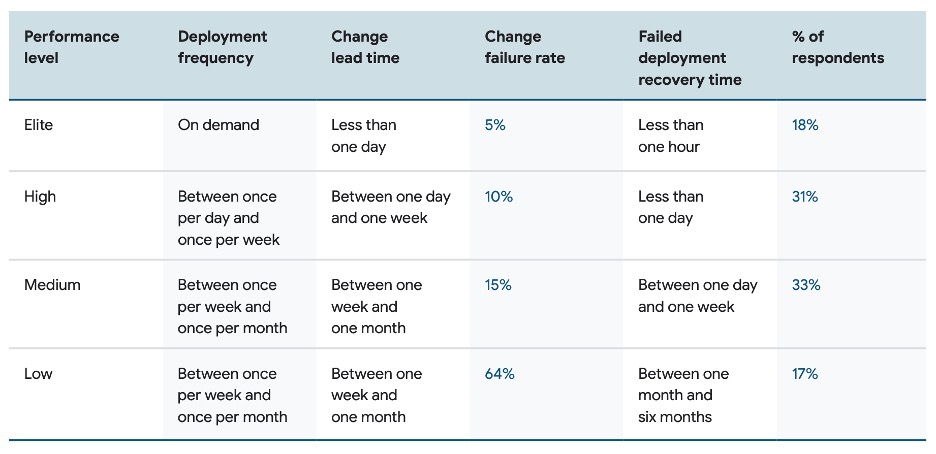

Summary
Focusing on pipeline execution time—rather than traditional output metrics like merged pull requests—reveals the real impact of development productivity. Reducing a pipeline’s runtime from 30 to 20 minutes across 100 daily runs saves approximately 16 hours per day, and scaling that across multiple pipelines delivers enormous gains in developer time and cost efficiency.
Equally important is pipeline stability, which is measured using DORA metrics like deployment frequency, lead time, change failure rate, and time to restore service.
Internal Developer Portals (IDPs) help achieve both by enforcing standardization, simplifying rollout of enhancements, improving visibility across pipelines, and encouraging continuous improvement.
Action points: track pipeline execution time and stability using DORA metrics, prioritize reducing runtime where possible, adopt an IDP for standardizing pipelines and enhancing monitoring, and use the freed-up developer time to drive innovation and higher-quality delivery.
Measuring developer productivity has always been a challenge in the software industry. Traditional metrics like committed code or merged pull requests provide some insight but often fail to capture the true impact of developers’ work.
Consider this scenario: a developer merges just one pull request in a week, consisting of only one line of code, yet this change could potentially save millions for the company. Why did it take so long for just one line of code? The answer lies in understanding the problem and the process that led to that line.
Now, imagine scaling this scenario to a larger enterprise with hundreds of developers. The task of measuring productivity becomes even more daunting. While it’s important to track metrics, especially in the era of remote work, relying solely on traditional metrics may not offer a clear view of development productivity.
What’s the role of pipeline execution time?
In my experience, prioritising pipeline execution time offers a more precise gauge of development productivity. Allow me to exemplify this with a scenario. Let’s say you manage a pipeline that runs a hundred times daily, requiring 30 minutes to go through all its stages.
Now, envision an enhancement is implemented, reducing the completion time down to 20 minutes. This seemingly minor adjustment yields a significant saving of 1000 minutes in development process time, approximately 16 hours.
Should this enhancement extend to other Integration/Continuous Deployment (CI/CD) pipelines within the enterprise (let’s assume another 100 pipelines), the cumulative effect results in a staggering 1600 hours of saved development time, equivalent to nearly 2 months of saved time that can be used for some other tasks. And let’s not overlook the impact on computing costs.
You might wonder how this relates to Internal Developer Portals (IDPs) and how they can help save time. IDPs are adopted to speed your development process but also to standardise the way software is created.
One of the aspects it standardises is development CI/CD pipelines and when all pipelines follow the same standards, rolling out changes becomes a matter of minutes or hours instead of months or quarters.
This not only makes the process more efficient but also encourages continuous improvement. Overall, optimising your development process through IDPs can lead to significant time savings and increased productivity.
What’s the importance of pipeline stability?
Pipeline optimisation does not always mean reducing time; stability is also of great importance. You might want to include new steps that could make your pipeline slower but more stable.
For main workloads, the DevOps Research & Assessment (DORA) team has defined four metrics that every pipeline should measure and monitor:
- Deployment frequency: This measures how often you release your workloads.
- Lead time for changes: This measures how long it takes for a commit in your repository’s main branch to reach production environments.
- Time to restore service: This represents the duration between the detection and resolution of an issue.
- Change failure rate: The rate of changes that cause an incident needs to be fixed.
This study also includes thresholds that categorise your pipeline efficiency into four categories: low, medium, high, and elite.
The following table shows a more comprehensive representation of these metrics and its categories:

Source: State of DevOps Report 2023, DevOps Research & Assessment (DORA)
CI/CD pipelines have become indispensable tools for streamlining the process of delivering high-quality software at speed, directly impacting productivity, development velocity, and user experience (faster bug fixing leads to happier users).
Ensuring that your pipeline processes produce the best outcomes is crucial in today’s fast-paced business environment.
In the ever-evolving landscape of software development, CI/CD pipelines face numerous challenges in maintaining seamless automation. Based on my experience, teams frequently encounter difficulties in keeping their automation running smoothly.
What are challenges in CI/CD optimisation?
Despite the benefits of CI/CD pipelines, many organisations encounter challenges in optimising them for maximum efficiency. Some common hurdles include:
- Complexity: As pipelines grow in complexity or numbers, managing dependencies, orchestrating tasks, and troubleshooting issues becomes increasingly challenging.
- Visibility: A lack of visibility into the pipeline stages, metrics and status can lead to delays in identifying and addressing bottlenecks or failures.
- Resource management: Optimising resource allocation and utilisation across multiple projects and teams can be complex without centralised control and monitoring.
- Onboarding: New team members often face steep learning curves when joining projects with intricate CI/CD pipelines, highlighting the importance of comprehensive documentation and onboarding processes.
How do Internal Developer Portals help?
Internal Developer Portals (IDPs) offer a robust solution to many of the challenges faced by organisations in optimising their CI/CD pipelines.
Here’s how IDPs can help overcome common hurdles:
Complexity
IDPs simplify this process by providing a centralised platform that integrates various tools and services. This integration streamlines workflows, making it easier to manage and coordinate complex tasks. IDPs often come with built-in automation and orchestration capabilities, reducing the manual effort required to maintain and update pipelines. You can configure your CI/CD pipelines by the tasks they are built for and reuse them across multiple repositories. In some CI/CD orchestrators, you can reference a common pipeline, providing great flexibility: optimising one change and making it available for use across all your workloads.
Visibility
IDPs enhance visibility by offering comprehensive dashboards and real-time monitoring tools. These tools provide insights into every stage of the pipeline, enabling teams to quickly pinpoint issues and monitor performance metrics. Enhanced visibility ensures that teams can proactively address problems, leading to more efficient and reliable pipeline operations.
Resource management
IDPs centralise resource management, allowing organisations to allocate resources more effectively. They provide a unified view of resource usage, making it easier to identify underutilised assets and reassign them as needed. This centralised approach ensures optimal utilisation of resources, reducing waste and improving overall efficiency.
Onboarding
IDPs can facilitate smoother onboarding by providing standardised environments and configurations. With one-click configuration, developers do not need to worry about deployment details. The deployment process for a piece of software is defined once and can be used multiple times.
Conclusion
Adopting IDPs presents a transformative opportunity for optimising development processes and enhancing productivity within organisations. By standardising the approach to software development, particularly in the management of CI/CD pipelines, IDPs streamline the deployment of changes across projects and provide standard metrics that, without using IDPs, would need to be embedded in each pipeline individually to ensure proper instrumentation.
This standardisation not only accelerates the implementation of improvements but also fosters a culture of continuous enhancement.
Through IDPs, organisations can effectively navigate the complexities of modern software development at scale, achieving significant time savings, increased development velocity, and reduced time-to-market.
As the digital landscape continues to evolve, embracing IDPs emerges as a strategic imperative for organisations seeking to remain competitive and agile in today’s dynamic market.
Find out more about Calibo’s IDP here.
FAQ
Why is pipeline execution time so important?
Because even small reductions in runtime, when multiplied across many daily runs, free up significant developer hours and improve overall delivery speed.
How can teams measure pipeline stability?
By using DORA metrics such as deployment frequency, lead time for changes, change failure rate, and time to restore service to ensure reliable performance.
What role do Internal Developer Portals (IDPs) play in improving CI/CD pipelines?
IDPs standardize pipelines, make enhancements easier to roll out, improve visibility into performance, and help teams continuously optimize productivity.
Trending articles

How Enterprise Architects can get more support for technology led innovation
Enterprise Architects are increasingly vital as guides for technology-led innovation, but they often struggle with obstacles like siloed teams, misaligned priorities, outdated governance, and unclear strategic value. The blog outlines six core challenges—stakeholder engagement, tool selection, IT-business integration, security compliance, operational balance, and sustaining innovation—and offers a proactive roadmap: embrace a “fail fast, learn fast” mindset; align product roadmaps with enterprise architecture; build shared, modular platforms; and adopt agile governance supported by orchestration tooling.

Why combine an Internal Developer Portal and a Data Fabric Studio?
Discover how to combine Internal Developer Portal and Data Fabric for enhanced efficiency in software development and data engineering.

The differences between data mesh vs data fabric
Explore the differences of data mesh data fabric and discover how these concepts shape the evolving tech landscape.

Best practices for developing AI solutions with a self-service platform
Discover how developing AI solutions with a self-service platform can enhance productivity and efficiency in your enterprise.

More from Calibo
One platform, whether you’re in data or digital.
Find out more about our end-to-end enterprise solution.